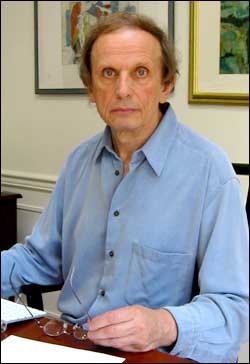Jul 22 2008
Radoslav Adzic, a senior chemist at the U.S. Department of Energy's (DOE) Brookhaven National Laboratory, has received a 2008 DOE Hydrogen Program R+D Award, which recognizes him for his "outstanding contributions in electrocatalysis for fuel cells." Adzic was honored in June with a plaque at a DOE ceremony held in Washington, D.C.
 Radoslav Adzic
Radoslav Adzic
Adzic has been conducting studies in surface electrochemistry and electrocatalysis for a considerable part of his career using various techniques, including atomic-level surface characterization with x-rays at Brookhaven’s National Synchrotron Light Source. Recently, he has focused on making efficient catalysts that may be used to convert hydrogen to electricity in fuel cells for electric vehicles.
“The rising cost of gasoline and concerns about global warming have made my research particularly relevant today,” Adzic said. “It is difficult to predict exactly when the new technologies will be made commercial, and whose inventions will be used, but the progress in designing electrocatalysts for hydrogen fuel cells has been significant in recent years. I am grateful for this recognition from the Department of Energy and glad that I can continue my research in this promising field.”
Adzic and his coworkers designed the first platinum monolayer fuel-cell anode electrocatalyst, which consists of ruthenium nanoparticles with a few platinum islands of monoatomic thickness. This electrocatalyst has long-term stability and the same catalytic activity as a standard, all-platinum electrocatalyst, which has ten times more platinum, and is therefore very expensive. This new electrocatalyst has the potential to reduce the cost and increase the efficiency of fuel cells in electric vehicles, among other applications.
Recently, Adzic and his team developed several types of platinum monolayer cathode electrocatalysts. One type, for example, consists of a core of a metal such as nickel, cobalt or iron, covered by a corrosion-resistant metal shell, such as palladium, gold, or iridium, covered with a platinum monolayer. These electrocatalysts have high activity and a very low platinum content, and their long-term stability tests are underway. In addition, Adzic and his team found that gold clusters can increase the stability of platinum electrocatalysts. While platinum is the most efficient electrocatalyst for accelerating chemical reactions in fuel cells in electric cars, it dissolves in reactions during stop-and-go driving, and that is a major impediment. The addition of gold clusters kept the platinum intact during an accelerated stability test under laboratory conditions, which may be a big breakthrough in fuel-cell technology. Several long-term fuel-cell tests have to be completed to optimize these electocatalysts for commercial applications.
Radoslav Adzic earned a B.S. in chemical technology in 1965 and a Ph.D. in chemistry in 1974, both from the University of Belgrade. He remained at the university, eventually becoming a professor and Director of the Institute of Electrochemistry. In 1979, he came to Brookhaven as a visiting scientist, and, in 1992, he joined the Laboratory as a senior research associate, rising to the position of chemist in 2001, and senior chemist in 2005.
Adzic won the Annual Award of Belgrade for Natural Sciences in 1983, the Medal of the Serbian Chemical Society in 1997, Brookhaven Lab’s Science and Technology Award in 2005, and the Research Award of The Electrochemical Society’s Energy Technology Division in 2007. He was elected as a correspondent member of the Serbian Academy of Sciences and Arts in 1993, and he became a Fellow of The Electrochemical Society in 2005.